Astronomy
Complete KIM and study guide
Biology
Complete EOC study guide
Monday, April 29, 2019
Monday, April 22, 2019
Week of April 22, 2019
ASTRONOMY
THE MOON
The moon is the easiest celestial object to find in the night sky — when it's there. Earth's only natural satellite hovers above us bright and round until it seemingly disappears for a few nights. The rhythm of the moon's phases has guided humanity for millennia — for instance, calendar months are roughly equal to the time it takes to go from one full moon to the next.
Moon phases and the moon's orbit are mysteries to many. For example, the moon always shows us the same face. That happens because it takes 27.3 days both to rotate on its axis and to orbit Earth. We see either the full moon, half moon or no moon (new moon) because the moon reflects sunlight. How much of it we see depends on the moon's position in relation to Earth and the sun.
Though a satellite of Earth, the moon, with a diameter of about 2,159 miles (3,475 kilometers), is bigger than Pluto. (Four other moons in our solar system are even bigger.) The moon is a bit more than one-fourth (27 percent) the size of Earth, a much smaller ratio (1:4) than any other planets and their moons. This means the moon has a great effect on the planet and very possibly is what makes life on Earth possible.
CLOSE
Volume 0%
How did the moon form?
There are various theories about how the moon was created, but recent evidence indicates it formed when a huge collision tore a chunk of Earth away.
The leading explanation for how the moon formed was that a giant impact knocked off the raw ingredients for the moon off the primitive molten Earth and into orbit. Scientists have suggested the impactor was roughly 10 percent the mass of Earth, about the size of Mars. Because Earth and the moon are so similar in composition, researchers have concluded that the impact must have occurred about 95 million years after the formation of the solar system, give or take 32 million years. (The solar system is roughly 4.6 billion years old.) New studies in 2015 gave further weight to this theory, based on simulations of planetary orbits in the early solar system, as well as newly uncovered differences in the abundance of the element tungsten-182 detected in the Earth and the moon.
Although the large impact theory dominates the scientific community's discussion, there are several other ideas for the moon's formation. These include that the Earth captured the moon, that the moon fissioned out of the Earth, or that Earth may even have stolen the moon from Venus, according to a recent theory.
How Did the Moon Form?
Volume 0%
Internal structure
The moon very likely has a very small core, just 1 to 2 percent of the moon's mass and roughly 420 miles (680 km) wide. It likely consists mostly of iron, but may also contain large amounts of sulfur and other elements.
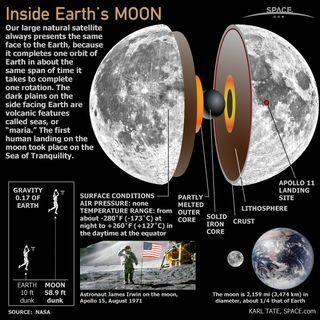
(Image: © Karl Tate, SPACE.com)
Its rocky mantle is about 825 miles (1,330 km) thick and made up of dense rocks rich in iron and magnesium. Magmas in the mantle made their way to the surface in the past and erupted volcanically for more than a billion years — from at least four billion years ago to fewer than three billion years past.
The crust on top averages some 42 miles (70 km) deep. The outermost part of the crust is broken and jumbled due to all the large impacts it has received, a shattered zone that gives way to intact material below a depth of about 6 miles (9.6 km).
Surface composition
Like the four inner planets, the moon is rocky. It's pockmarked with craters formed by asteroid impacts millions of years ago. Because there is no weather, the craters have not eroded.
The average composition of the lunar surface by weight is roughly 43 percent oxygen, 20 percent silicon, 19 percent magnesium, 10 percent iron, 3 percent calcium, 3 percent aluminum, 0.42 percent chromium, 0.18 percent titanium and 0.12 percent manganese.
Orbiters have found traces of water on the lunar surface that may have originated from deep underground. They have also located hundreds of pits that could house explorers who remain on the moon long-term. [Photos: Our Changing Moon]
Ongoing observations from the Lunar Reconnaissance Orbiter (LRO) showed that water is more abundant on slopes facing the lunar south pole, although scientists do caution that the water quantity is comparable to an extremely dry desert. Meanwhile, a 2017 study suggested the moon's interior could be abundant in water, too.

Uncle Milton Moon in My Room. Buy Here
(Image: © Space.com Store)
Atmosphere of the moon
The moon has a very thin atmosphere, so a layer of dust — or a footprint — can sit undisturbed for centuries. And without much of an atmosphere, heat is not held near the surface, so temperatures vary wildly. Daytime temperatures on the sunny side of the moon reach 273 degrees F (134 C); on the dark side it gets as cold as minus 243 F (minus 153 C).
Orbital characteristics
Here are some numbers from NASA:
- Average distance from Earth: 238,855 miles (384,400 km)
- Perigee (closest approach to Earth): 225,700 miles (363,300 km)
- Apogee (farthest distance from Earth): 252,000 miles (405,500 km)
- Orbit circumference: 1,499,618.58 miles (2,413,402 km)
- Mean orbit velocity: 2,287 mph (3,680.5 km/h)
Advertisement
Orbit/Earth relationship
The moon's gravity pulls at the Earth, causing predictable rises and falls in sea levels known as tides. To a much smaller extent, tides also occur in lakes, the atmosphere, and within Earth's crust.
High tides are when water bulges upward, and low tides are when water drops down. High tide results on the side of the Earth nearest the moon due to gravity, and it also happens on the side farthest from the moon due to the inertia of water. Low tides occur between these two humps.
The pull of the moon is also slowing the Earth's rotation, an effect known as tidal braking, which increases the length of our day by 2.3 milliseconds per century. The energy that Earth loses is picked up by the moon, increasing its distance from the Earth, which means the moon gets farther away by 1.5 inches (3.8 centimeters) annually.
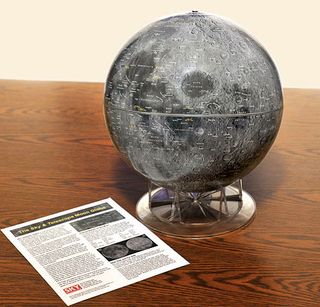
12" Moon Globe. Buy Here
(Image: © Space.com Store)
The moon's gravitational pull may have been key to making Earth a livable planet by moderating the degree of wobble in Earth's axial tilt, which led to a relatively stable climate over billions of years where life could flourish.
The moon doesn't escape from the interplay unscathed. A new study suggests that Earth's gravity stretched the moon into its odd shape early in its lifetime.
SOURCE: https://www.space.com/55-earths-moon-formation-composition-and-orbit.html
BIOLOGY
Natural selection in populations
How natural selection works at the level of genes, alleles, genotypes, & phenotypes.
Key Points
- Natural selection can cause microevolution (change in allele frequencies), with fitness-increasing alleles becoming more common in the population.
- Fitness is a measure of reproductive success (how many offspring an organism leaves in the next generation, relative to others in the group).
- Natural selection can act on traits determined by alternative alleles of a single gene, or on polygenic traits (traits determined by many genes).
- Natural selection on traits determined by multiple genes may take the form of stabilizing selection, directional selection, or disruptive selection.
Introduction
We've already met a few different mechanisms of evolution. Genetic drift, migration, mutation...the list goes on. All of these mechanisms can make a population evolve, or change in its genetic makeup over generations.
But there's one mechanism of evolution that's a bit more famous than the others, and that's natural selection. What makes natural selection so special? Out of all the mechanisms of evolution, it's the only one that can consistently make populations adapted, or better-suited for their environment, over time.
You may have already seen natural selection as part of Darwin’s theory of evolution. In this article, we will dive deeper – in fact, deeper than Darwin himself could go. We will examine natural selection at the level of population genetics, in terms of allele, genotype, and phenotype frequencies.
Quick review of natural selection
Here is a quick reminder of how a population evolves by natural selection:
- Organisms with heritable (genetically determined) features that help them survive and reproduce in a particular environment tend to leave more offspring than their peers.
- If this continues over generations, the heritable features that aid survival and reproduction will become more and more common in the population.
- The population will not only evolve (change in its genetic makeup and inherited traits), but will evolve in such a way that it becomes adapted, or better-suited, to its environment.
Natural selection can cause microevolution
Natural selection acts on an organism’s phenotype, or observable features. Phenotype is often largely a product of genotype (the alleles, or gene versions, the organism carries). When a phenotype produced by certain alleles helps organisms survive and reproduce better than their peers, natural selection can increase the frequency of the helpful alleles from one generation to the next – that is, it can cause microevolution.
Example: Rabbit coat color
As an example, let's imagine a population of brown and white rabbits, whose coat color is determined by dominant brown (B) and recessive white (b) alleles of a single gene. If a predator such as a hawk can see white rabbits (genotype bb) more easily than brown rabbits (BB and Bb) against the backdrop of a grassy field, brown rabbits are more likely than white rabbits to survive hawk predation. Because more brown than white rabbits will survive to reproduce, the next generation will probably contain a higher frequency of B alleles.
We can demonstrate this to ourselves by working through an example. Let's start with a set of allele and phenotype frequencies, shown in the diagram below, and see how they change in a generation if half of the white rabbits (but none of the brown rabbits) are eaten by hawks:
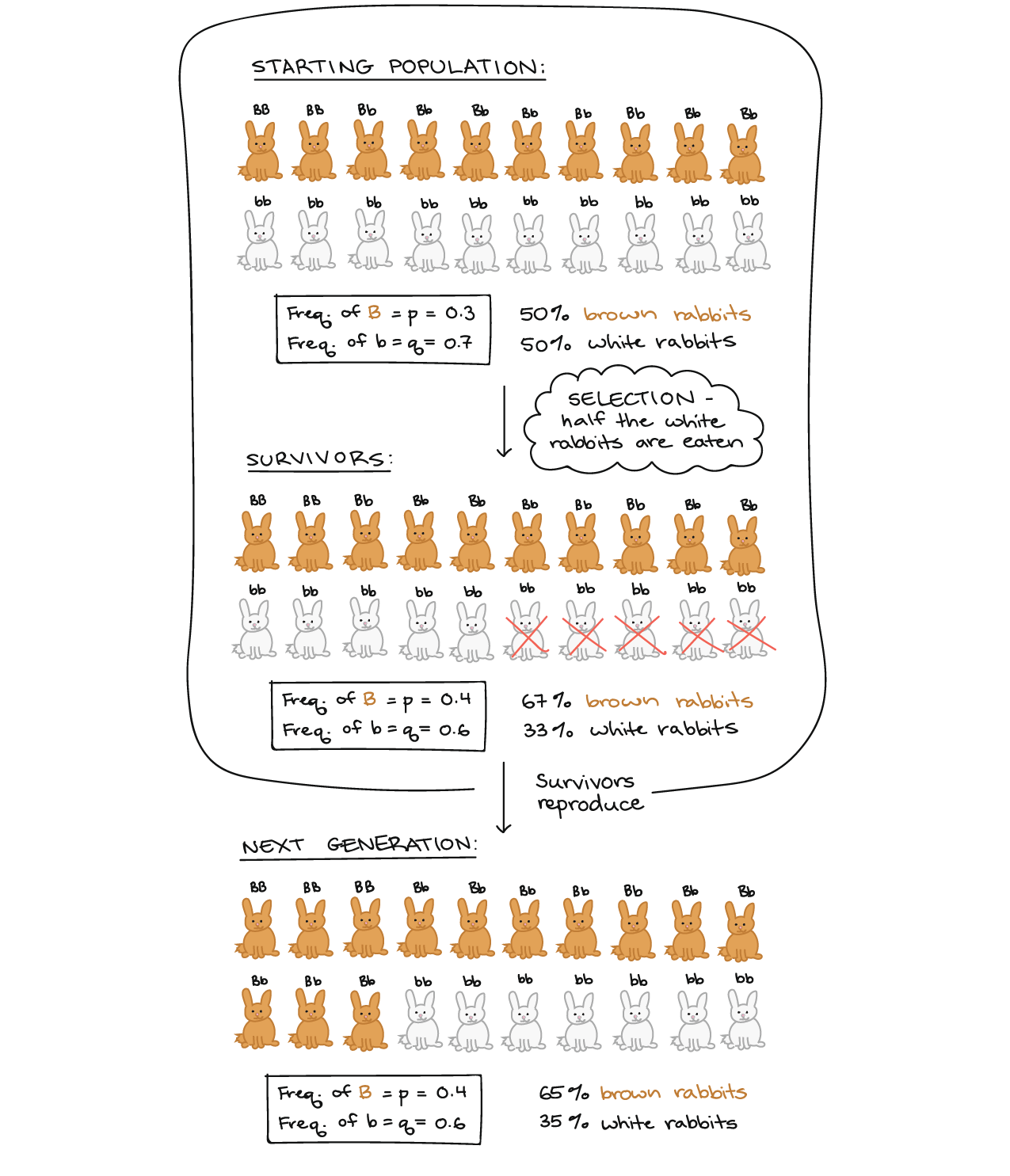
equals, 20
31073, plus, 10, equals, 137
In this example, the frequency of the survival-promoting B allele rose from 0.30, point, 3to 0.40, point, 4 in a single generation. The percent of the population with the survival-promoting brown phenotype also rose from 50%50, percent to 65%65, percent. (We can predict the next generation by assuming that the survivors mate randomly and leave equal numbers of offspring on average.) This is a made-up example, but it gives us a concrete sense of how natural selection can shift allele and phenotype frequencies to make a population better-suited to its environment.
Will the recessive b alleles disappear from the population due to selection? Maybe someday, but not right away. That's because they can “hide” from predators in the heterozygous (Bb) brown rabbits. This is a good reminder that natural selection acts on phenotypes, not genotypes. A hawk can tell a brown rabbit from a white rabbit, but it can't tell an BB rabbit from an Bb rabbit.
Fitness = reproductive success
The phenotypes and genotypes favored by natural selection aren't necessarily just the ones that survive best. Instead, they're the ones with the highest overall fitness. Fitness is a measure of how well organisms survive and reproduce, with emphasis on "reproduce." Officially, fitness is defined as the number of offspring that organisms with a particular genotype or phenotype leave behind, on average, as compared to others in the population.
Survival is one important component of fitness. In order to leave any offspring at all in the next generation, an organism has to reach reproductive age. For instance, in the example above, brown rabbits had higher fitness than white rabbits, because a larger fraction of brown rabbits than white rabbits survived to reproduce. Living for a longer period of time may also allow an organisms to reproduce more separate times (e.g., with more mates or in multiple years).
However, survival is not the only part of the fitness equation. Fitness also depends on the ability to attract a mate and the number of offspring produced per mating. An organism that survived for many years, but never successfully attracted a mate or had offspring, would have very (zero) low fitness.
Fitness depends on the environment
Which traits are favored by natural selection (that is, which features make an organism more fit) depends on the environment. For example, a brown rabbit might be more fit than a white rabbit in a brownish, grassy landscape with sharp-eyed predators. However, in a light-colored landscape (such as sand dunes), white rabbits might be better than brown rabbits at avoiding predators. And if there weren't any predators, the two coat colors might be equally fit!
In many cases, a trait also involves tradeoffs. That is, it may have some positive and some negative effects on fitness. For instance, a particular coat color might make a rabbit less visible to predators, but also less attractive to potential mates. Since fitness is a function of both survival and reproduction, whether the coat color is a net "win" will depend on the relative strengths of the predation and the mate preference.
Natural selection can act on traits controlled by many genes
In some cases, different phenotypes in a population are determined by just one gene. For example, this was the case with our hypothetical rabbits. It's also true in some real cases of natural selection for coat color (e.g., in mice)1,2start superscript, 1, comma, 2, end superscript.
However, in many cases, phenotypes are controlled by multiple genes that each make a small contribution overall result. Such phenotypes are often called polygenic traits, and they typically form a spectrum, taking many slightly different forms. Plotting the frequency of the different forms in a population often results in a graph with a bell curve shape. Height (see graph below) and many other traits in humans are polygenic.
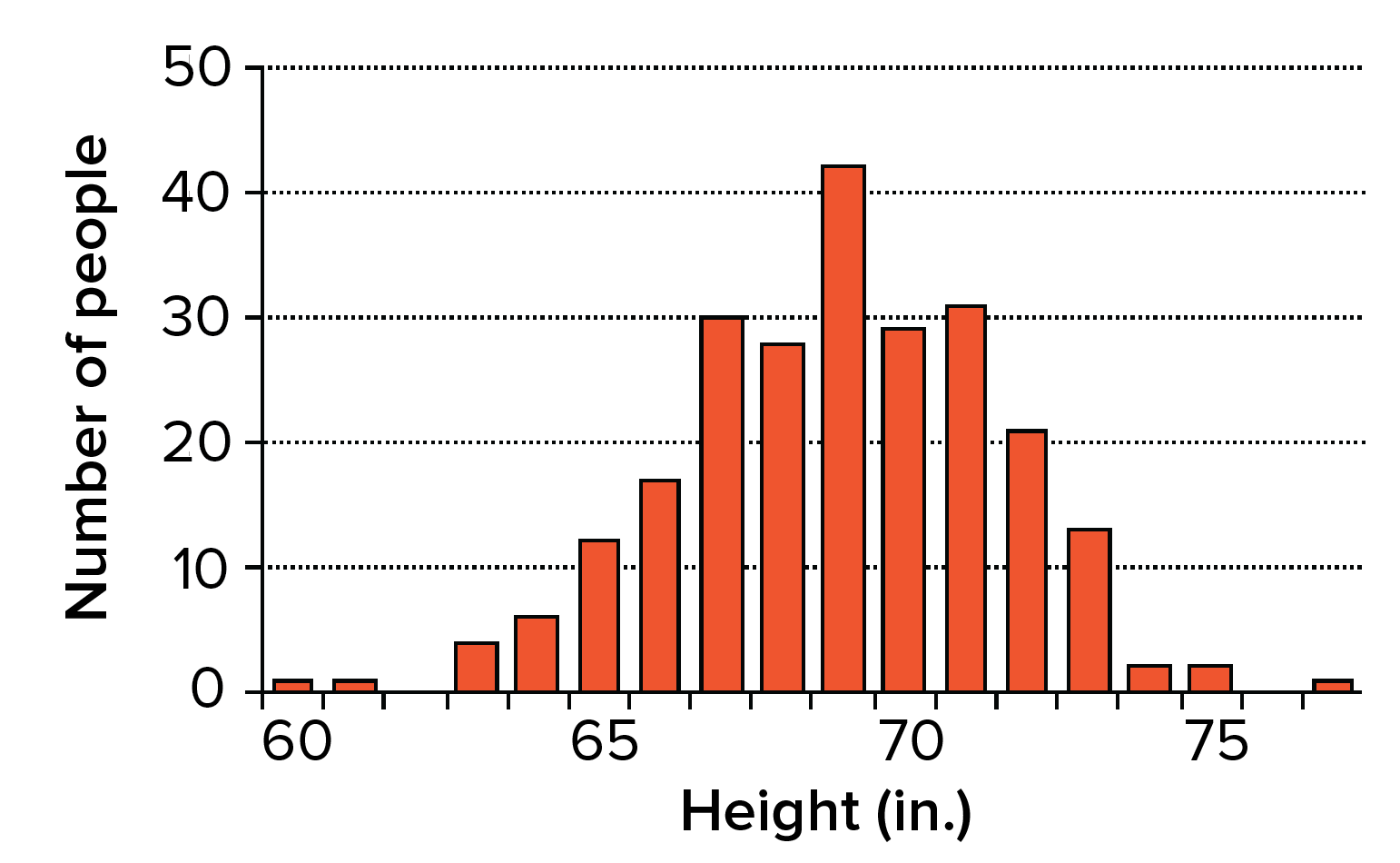
Histogram showing height in inches of male high school seniors in a sample group. The histogram is roughly bell-shaped, with just a few individuals at the tails (60 inches and 77 inches) and many individuals in the middle, around 69 inches.
Image modified from "Continuous variation: Quantitative traits," by J. W. Kimball (CC BY 3.0).
We can see if natural selection is acting on a polygenic trait by watching how the distribution of phenotypes in the population changes over time. Certain characteristic shifts tell us selection is occurring, even if we don’t know exactly which genes control the trait.
How natural selection can shift phenotype distributions
There are three basic ways that natural selection can influence distribution of phenotypes for polygenic traits in a population. To illustrate these forms of selection, let's use an imaginary beetle population, in which beetle color is controlled by many genes and varies in a spectrum from light to dark green.
- Stabilizing selection. In stabilizing selection, intermediate phenotypes are more fit than extreme ones. For example, medium-green beetles might be the best camouflaged, and thus survive best, on a forest floor covered by medium-green plants. Stabilizing selection tends to narrow the curve.

- Directional selection. One extreme phenotype is more fit than all the other phenotypes. For example, if the beetle population moves into a new environment with dark soil and vegetation, the dark green beetles might be better hidden and survive better than medium or light beetles. Directional selection shifts the curve towards the favorable phenotype.
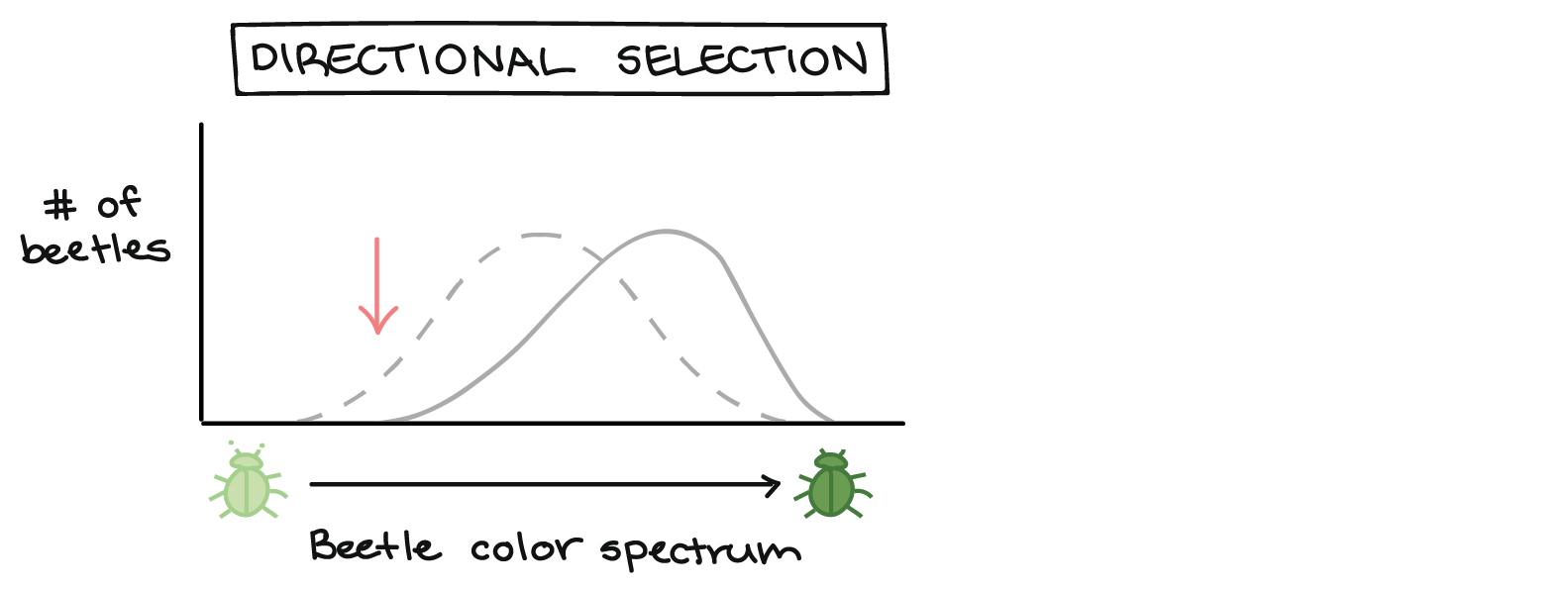
- Disruptive selection. Both extreme phenotypes are more fit than those in the middle. For example, if the beetles move into a new environment with patches of light-green moss and dark-green shrubs, both light and dark beetles might be better hidden (and survive better) than medium-green beetles. Diversifying selection makes multiple peaks in the curve.
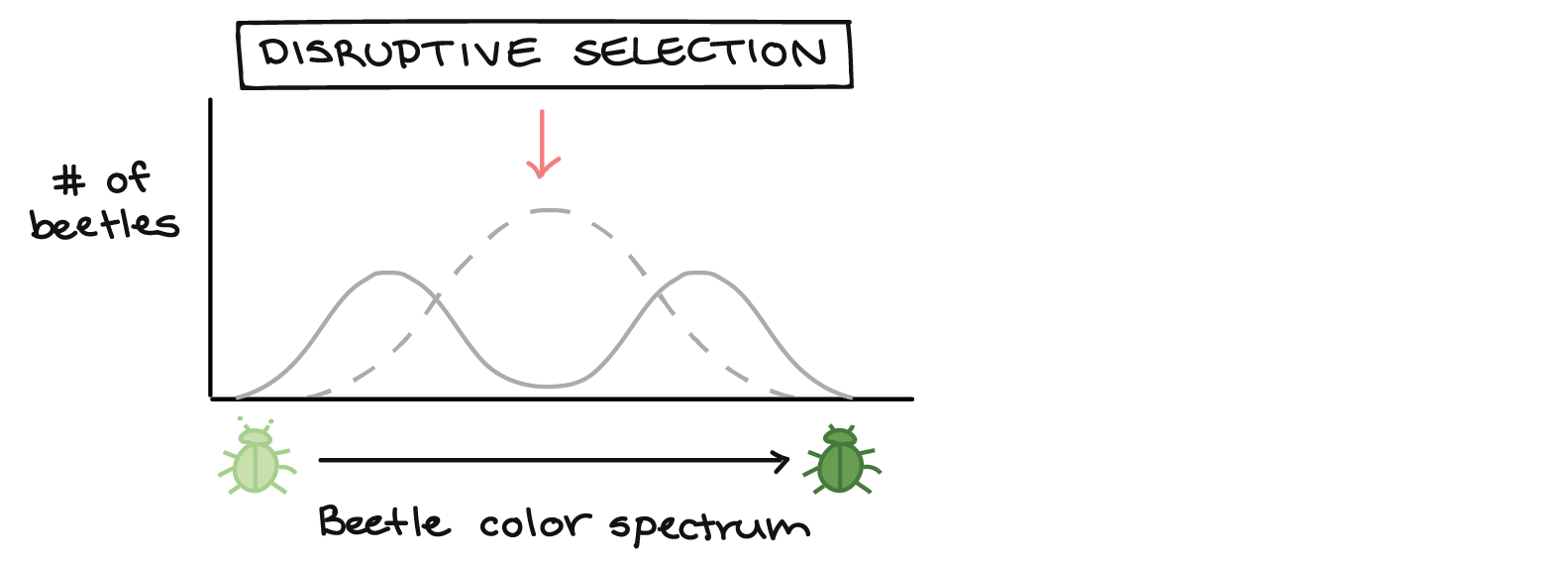
Summary
Natural selection can cause microevolution, or a change in allele frequencies over time, with fitness-increasing alleles becoming more common in the population over generations. Fitness is a measure of relative reproductive success. It refers to how many offspring organisms of a particular genotype or phenotype leave in the next generation, relative to others in the group.
Natural selection can act on traits determined by different alleles of a single gene, or on polygenic traits (traits determined by many genes). Polygenic traits in a population often form a bell curve distribution. Natural selection on polygenic traits can take the form of:
- Stabilizing selection: Intermediate phenotypes have the highest fitness, and the bell curve tends to narrow.
- Directional selection: One of the extreme phenotypes has the highest fitness. The bell curve shifts towards the more fit phenotype.
- Disruptive selection: Both extreme phenotypes have a higher fitness than intermediate phenotypes. The bell curve develops two peaks.
- SOURCE: https://www.khanacademy.org/science/biology/her/heredity-and-genetics/a/natural-selection-in-populations
Subscribe to:
Posts (Atom)